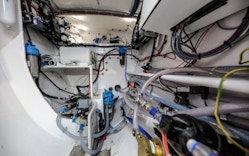The hydrogen chain step 1: The Energy Observer watermaker
The Energy Observer is equipped with a reverse-osmosis desalination system with several levels. When two volumes of water – one salty and the other not – are put together, natural movement is created: the fresh water is attracted to the salty water.
As the name suggests, reverse osmosis is the opposite, going from salty water to fresh water. In this process, seawater is forced through a filtering membrane which removes the salt. However, high energy resources are required to maintain water pressure. The fresh water generated by the first level of desalination is used on board. Water from the other levels is used by the on-board hydrogen systems.

The Energy Observer watermaker
On the Energy Observer, this process instantly consumes 250 W to produce 90 litres of drinking water, 30 of which are then treated again to be used by the electrolyser. 1 L of fresh water produces 100 g of H2 which becomes water again when the fuel cells make the conversion into electricity.
Note that the correct optimisation of the fluids means very pure steam can be recovered and re-injected into the electrolyser. As a result, the actual pure water consumed is only a back-up.